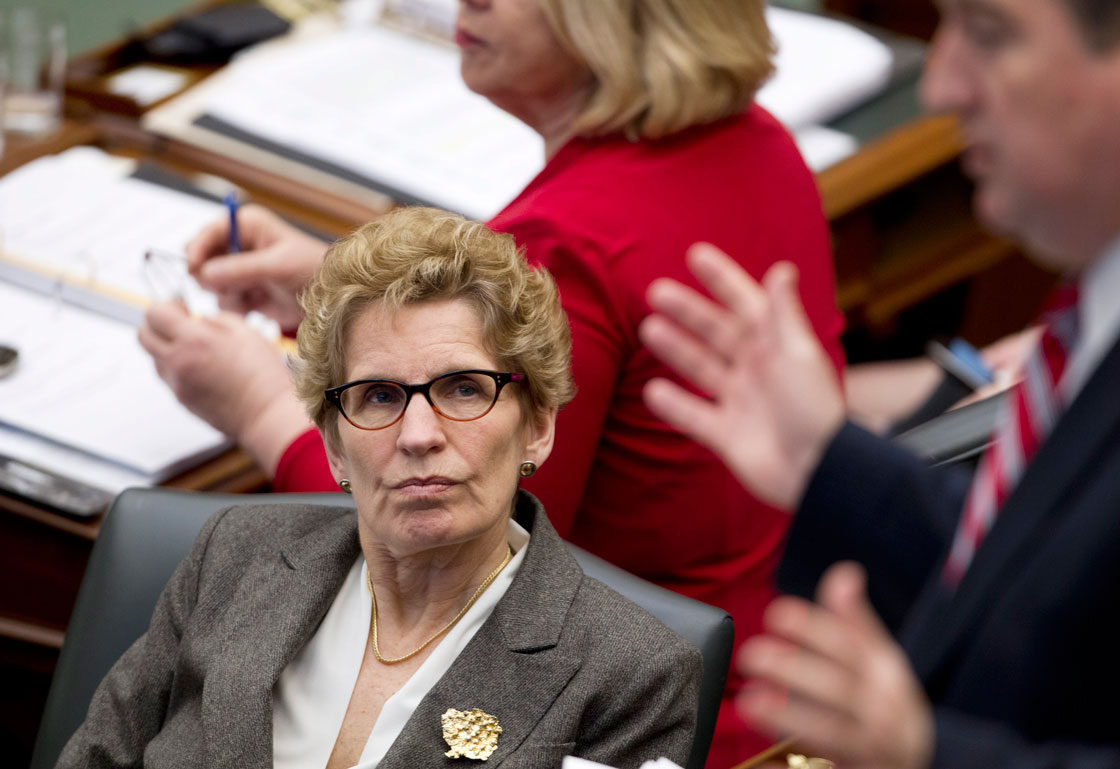If Ontario Premier Kathleen Wynne spends any time in her office on Monday, she will be treated to the sight of a giant red counter parked on the street outside her window, ticking slowly but surely toward a number Wynne and her party would probably rather avoid.

The number is $300,000,000,000 and it represents the province of Ontario’s net debt as of July 25, 2016. According to the Canadian Taxpayer’s Federation, the province will cross the $300-billion threshold around mid-day.
WATCH: Canadian Taxpayers Federation puts up ‘debt clock’ outside Queen’s Park

Debt is a reality for just about every government at every level. It represents the amount of money the government has borrowed from the general public, institutional investors and public-sector bodies.
So is $300 billion in debt (about $21,600 for every resident) enough to sink Ontario financially over the long term? Probably not, according to at least one expert, but that level of debt does carry significant risks.
A depressing outlook
Ontario’s financial watchdog doesn’t seem to be in the optimistic camp. A week ago, the Financial Accountability Office predicted the province’s net debt will balloon by another $50 billion to $350 billion over the next four years.
- Train goes up in flames while rolling through London, Ont. Here’s what we know
- Budget 2024 failed to spark ‘political reboot’ for Liberals, polling suggests
- Wrong remains sent to ‘exhausted’ Canadian family after death on Cuba vacation
- Peel police chief met Sri Lankan officer a court says ‘participated’ in torture
READ MORE: Financial watchdog warns Ontario’s debt will grow to $350 billion in four years
The watchdog is largely blaming the Liberal government’s $160-billion, 12-year plan to invest in infrastructure and public transit projects for the trend.
In a 600-page report released in late 2014, provincial auditor general Bonnie Lysyk was already warning about the growing debt, pointing out that the government was, at that point, spending more on debt interest payments than on post-secondary education.
A large debt-load can have several negative effects, Lysyk noted, not the least of which is that the government needs to divert money away from other programs in order to cover the interest payments and pay down what it owes.
WATCH: Kevin O’Leary calls Ontario a ‘legacy of waste’ over high debt level

High debt also leaves Ontario vulnerable to interest rate increases and credit-rating downgrades, which could lead to higher borrowing costs in the years to come, the auditor general added.
In June, the Parliamentary Budget Officer put up its own red flag with a report that stated the combined net debt of Canada’s so-called “sub-national governments” (all governments except the federal one) is projected to rise to more than 200 per cent of GDP after 75 years.
“The total government sector in Canada … is not fiscally sustainable without permanent increases in revenues or reductions in program spending,” the document noted.
Compared to other provinces, Ontario’s situation looks particularly dire on the surface. Between 2003-04 and 2015-16, the province’s debt level increased more than any of its neighbours, and it easily takes the prize for highest net debt of any province or territory. (Quebec, however, still has more debt per resident, at just over $22,700.)
The silver lining
All of this seems pretty awful, but according to Sheila Block, senior economist with the left-leaning Canadian Centre for Policy Alternatives, Ontario isn’t heading for a fiscal cliff.
“I absolutely don’t think we’re heading towards a debt wall,” Block said.
Rather than just looking at the raw debt numbers, she explained, it’s more important to measure debt against the gross domestic product of any given jurisdiction. In that respect, Ontario is doing fine for now, with a debt-to-GDP ratio just under 40 per cent.
WATCH: Ontario’s net debt expected to exceed $300 billion in budget
-FEB_25_tnb_4.jpg?w=1040&quality=70&strip=all)
“The (International Monetary Fund) and the (Organisation for Economic Co-operation and Development) have bars for where an economy is in trouble, where government debt is above a certain level,” Block said.
“Ontario, at less than 40 per cent (debt-to-GDP), is absolutely not in that kind of trouble.”
Economists have not established an ideal debt-to-GDP number, but economically troubled Greece, in contrast to Ontario, has a ratio around 175 per cent.
According to Block, there is also continued appetite in financial markets for Ontario’s debt, meaning investors still expect to get their money back, and “a sizable proportion” of Ontario’s debt is going towards investment in infrastructure.
“Those investments increase economic productivity, which increases GDP, which increases the capacity to pay taxes and pay off that debt. And it’s also important socially.”
READ MORE: Canada among 7 countries most vulnerable to debt crisis: economist
Finally, Block noted, you need to take into account historically low interest rates. While there is always a risk that the rates will increase, she acknowledged, the province has shifted sharply toward longer-term debt to better shield itself.
“Despite the increase in debt, we’re seeing that interest costs as a share of revenues are about steady for Ontario,” she said.
With files from the Canadian Press.




Comments